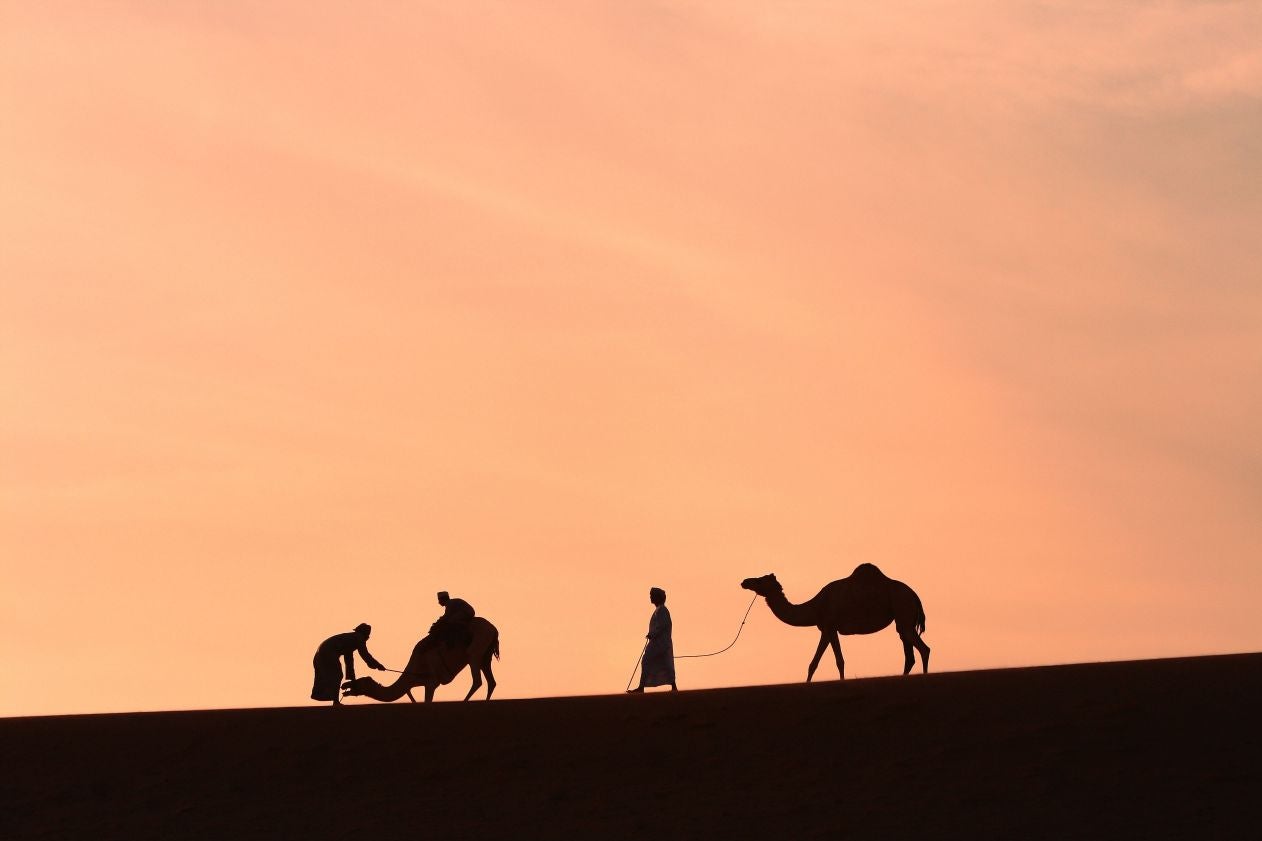The Independent's journalism is supported by our readers. When you purchase through links on our site, we may earn commission.
Trail of the Unexpected: Greenery and grandeur in Oman

We must be in the wrong place. This was the immediate conclusion I arrived at as our guide, Mahad, pulled off to the side of the road and killed the engine. While he pottered about in the boot for the picnic, laying out a blanket and several bowls of exotic-looking food, I held a quick internal debate about whether or not I should believe my eyes.
Beside us was a muddy brown river bordered by grassy banks – so green they looked as though they might be lime-flavoured. Rising up on the opposite shore were mist-shrouded mountains covered in trees, which, from where I was sitting, looked like mini florets of broccoli. This was not at all what I was expecting from the Middle East.
"What do you think?" asked Mahad, with a glint in his eye. I'd only ever seen landscapes like this in the Amazon rainforest. And yet, according to the stamp on my passport (and the registration plate on Mahad's car), I was on the south coast of Oman. So where was all the sand?
There was plenty of it back at the hotel. Located right on the beach at Salalah, the Hilton is one of several resorts that have sprung up here in recent years. With the turquoise Arabian Sea on your doorstep and miles of white sand stretching out in either direction, it ticks all the usual boxes. Yet for some reason most Brits only go as far as the capital city, Muscat, located in the north – remaining oblivious to the surprise that awaits this part of Oman.
The reason for the Dhofar Mountains' ostentatious greenery is that they trap moist air coming off the Arabian Sea – creating a coastal microclimate. The result is that you get plenty of sun, without the intense heat normally associated with desert countries. Come here in June, as I did, and the greenery is even more spectacular – fuelled by the monsoon winds that blow across from India.
The other reason for coming to the south of Oman is the fact that it's packed with historical treasures. After collecting me from the hotel earlier that morning, Mahad had taken me on a magical history tour that began at al Baleed National Park. Located half an hour from Salalah, this Unesco World Heritage Site is home to the remains of Zafar – an ancient port city dating back to around 2000BC. Up until the 16th century it did a roaring trade with the likes of India, Africa and China – exporting horses, gold and frankincense. The latter made the Middle East rich before anyone had even thought about oil.
From here we headed to Khor Rori – the ruins of an ancient fortified town overlooking a lagoon. Like Zafar, this place prospered thanks to frankincense, but many of its houses have been worn away by centuries of dry winds and salty air. In my experience, visitors to such sites are normally kept at arm's length from the exhibits; yet here we were, nonchalantly strolling around the biscuit-coloured buildings that are sprinkled across the hilltop.
The view from here has remained unchanged in centuries: spread out in front was a jade-green lagoon, with a flock of feeding flamingoes lining the water's edge like decorative sculptures. Behind me were those lush green mountains, rising up out of the flat, rocky plane that leads away from the coast. These formed a natural border between us and our ultimate destination – the Lost City of Ubar.
After a leisurely picnic, we climbed out over the other side and I got my first glimpse of proper desert. The mist suddenly lifted, and we found ourselves staring out over an arid landscape that stretched away into the shimmering distance.
What we were looking at was the Empty Quarter – a vast expanse of desert that covers more land than France, Holland and Belgium combined, and is one of the most sparsely populated areas on the planet. To this day, one of the few people to explore it is British adventurer Wilfred Thesiger, whose book on the subject, Arabian Sands, is considered a travel-writing classic.
Despite becoming familiar with several Bedouin clans – who are among the only people hardy enough to call this place home – Thesiger never managed to find the mythical city of Ubar. In fact it took scientists and historians until 1992 to find the place, using Nasa satellite technology to spot traces of the old caravan trails that lead here.
Tucked away in the barren wilderness, it's more a collection of random ruins than a lost city. Dating back to around 3000BC, it was a thriving trading post for frankincense merchants from all over the Middle East, until the first century AD, when its water source became squashed by a huge boulder, making the place uninhabitable. As with al Baleed and Khor Rori, this is history that you can get up close and personal with – assuming you can stand the roasting 50C heat, that is. The moment we got out of the car, it felt as though someone was directing a pair of hairdryers up my trouser legs.
If I was looking for bona fide desert, I'd come to the right place at last.
Matt Carroll stayed at the Hilton Salalah (00 968 23 211 234; hilton.com ). For a list of tour operators contact the Oman Tourist Office on 020-8877 4524 or oman@representationplus.co.uk. For more information on Oman visit omantourism.gov.om
Subscribe to Independent Premium to bookmark this article
Want to bookmark your favourite articles and stories to read or reference later? Start your Independent Premium subscription today.

Join our commenting forum
Join thought-provoking conversations, follow other Independent readers and see their replies